Sadik Kwaish Alfraji
on his Art Project 'Books of Passages' ,
Three Generations of Migration,
Identity, Layers of Memories, Expression and Thoughts through Art
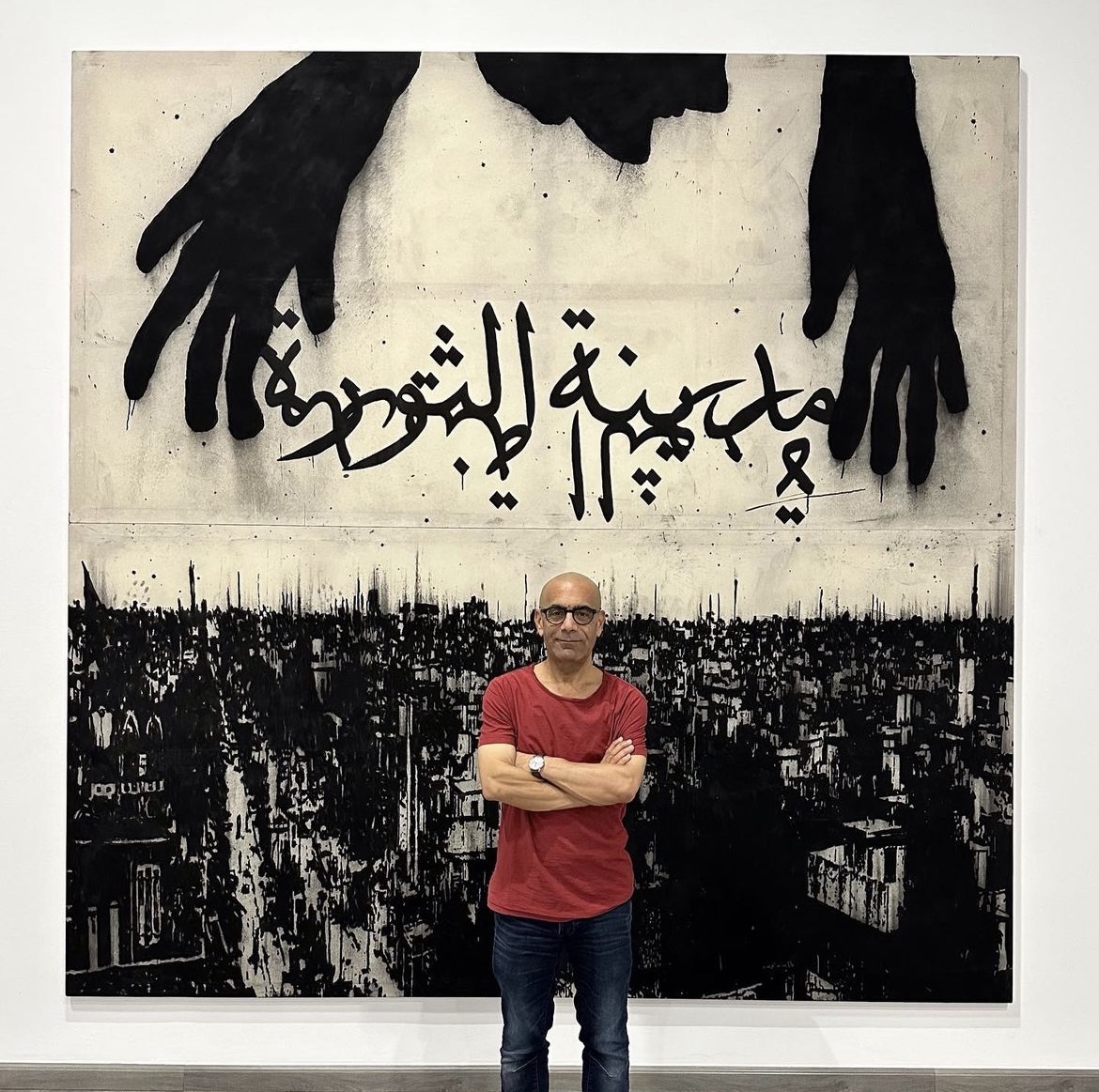
Sadik Kwaish Alfraji in front of his work 'Create a City of Love and Nightmares' 301 x 302 cm. Indian ink and Charcoal on canvas 2023, at Ayyam Gallery Dubai at his exhibition 'Those Houses Behind the Army Canal’, the second chaper of 'Books of Passage'.
Through art, Sadik Kwaish Alfraji conveys his feelings, thoughts, subconscious and consciousness, on migration, exile, displacement, loss, alienation, identity and memories.
His works of art relay his and his family’s experiences and his reflections on what he calls ‘the problem of existence’.
Figures made up of either charcoal or ink assume the void that the artist has felt, and the layers of memories that he contemplates on.
Drawings, paintings, video animations, art books, graphic art and installations form part of Sadik Kwaish Alfraji’s body of work, engulfing the viewer into the artist’s mind, his visual storytelling, and into a world of deep significance, where intensity and philosophy intertwine releasing striking and bold strokes of art.
The artist’s project ‘Book of Passages’ make up three chapters, a series on his grandfather’s generation, his father’s and his own.
The first chapter, entitled 'The River That Was in the South' (2019) was shown at the Stedelijk Museum in Amsterdam, the Ayyam Gallery in Dubai and the Cairo Biennale. The second chapter ‘Those Houses Behind the Army Canal’, currently on at Ayyam Gallery in Dubai, is a solo exhibition concerning his father’s generation and their migration from the South to Baghdad, where they were forced to live in slums. As the Republic of Iraq was declared, the intention to relocate the community materialised, with each family given some land to build their own house, in an area that then became known as Madinat al- Thawra (Revolution City), isolated from the rest of the city by a canal. Sadik Kwaish Alfraji engages in art with the history of his city, the disillusion of a new neighbourhood, his family’s life story and subsequent emotions.
Sadik Kwaish Alfraji conveys to us what lies behind his expressive works, how art played a role in his life, how he managed to portray his thoughts through art when he was living in Baghdad under a dictatorial regime, how his art depicts migration, exile, loss, and how he revives in art different layers harbouring in his memory and what they mean to him.
What are some of your earliest memories regarding your interest in art?
Everything that surrounds us, or in our minds, can become a subject of interest for art…there is nothing specific that is. However, I do think that the memories we keep and store, that are directly related to emotion or our consciousness, are closer to the process of artistic creation.
For me, it is the memory of my family’s house, the city it was built in, and everything that happened in relation to that, all of which, are a treasure of endless stories that relentlessly move in my head and constantly inspire me.
ما هي بعض ذكرياتك المبكرة عن اهتمامك بالفن؟
.كل شي من حولنا، او في ذاكرتنا، يمكن له ان يكون موضوعا للفن.. لا شئ محدد.. لكنني مع ذلك، اعتقد ان خزين الذاكرة الذي يتصل مباشرة بالعاطفة او الوجدان، هو اقرب الى عملية الخلق الفني بالنسبة لي
.شخصيا تشكل عندي ذاكرة البيت وا لمدينة، وكل ما يقع بينهما، ويحدث فيهما، كنزا لا ينتهي من القصص التي تتحرك في رأسي دون هوادة وتلهمني باستمرار
You describe your creativity as exploring ‘the problems of existence’, can you share with us a bit more about your thoughts around that? And how has philosophy played a part in your art?
I cannot separate my art practice from feeling the pressure of existence in the world…All conditions, such as love, anxiety, sadness, happiness, fear, waiting, doubt, loss, alienation, and so forth, control my being. I make art, in, between and under those sentiments. My mind thinks, watches, judges, wonders, and composes stories from all of those elements; stories that meet with intense emotion, whose roots extend back to the first moment of awareness, and fill my heart.
With regards to philosophy, it is, in short, a way to raise questions, those questions that put us at the heart of the problem of existence. That is exactly what art does, but in its own language, surpassing reason and transcending philosophy.
As I create, I leap into philosophy, and feel the greatness and majesty of that ascent upon completing a work. Art liberates me from the torment of my mind, and although it also carries within it the question of existence, it nevertheless frees itself from the impasse and dilemma of the mind and its difficult questions, thus art, takes me by the hand on towards a temporary break.
أنت تصف إبداعك بأنه استكشاف "مشاكل الوجود" ، هل يمكنك مشاركتنا المزيد حول أفكارك؟
وكيف لعبت الفلسفة دورًا في فنك؟
لا استطيع ان افصل بين ممارستي للفن وبين احساسي بضغط الشروط التي يفرضها وجودي في العالم.. انا موجود هنا، وتتحكم في كينونتي كل معطيات الوجود، كالحب والقلق والحزن والسعادة والخوف وا لانتظار والشك والفقدان وا لاغتراب، الى آخره.. أصنع الفن بين )في / تحت( شروط الوجود هذه، وداخل رأسي عقل يفكر ويراقب ويحكم ويتساءل ويركب حكايات من كل ذلك.. حكايات تلتقي مع عاطفة شديدة تملأ قلبي وتمتد جذورها الى لحظات الوعي ا لاولى
وبخصوص الفلسفة، فهي باختصار طريقة في إثارة السؤال.. السؤال الذي يضعنا في قلب مشكلة الوجود، وهذا تماما ما يفعله الفن بلغته الخاصة التي تتخطى العقل وتقفز فوق الفلسفة.. لذلك استطيع القول انني اتفلسف ح ين انخرط في انجاز عمل فني، واشعر بعظمة وج لال تلك القفزة ح ين انجز ذلك العمل.. الفن يحررني من عذاب العقل، ورغم انه يحمل بداخله سؤال الوجود، إلا انه بقفزته تلك يتحرر من مأزق العقل ومعضلة أسئلته الصعبه آخذا بيدي الى استراحة مؤقتة
When and how did your ink and charcoal figures emerge and become absorbed into your body of work?
I have worked with charcoal and ink since studying at the Art Institute in Baghdad, but my use of these materials have certainly increased with time, as it became clearer that the graphic sensitivity and expressive power found in them, corresponded well to the nature of my work which grew more focused on storytelling.
متى وكيف ظهرت أشكال الفحم الخاصة بك وانغمست في عملك؟
الفحم والحبر كان موجود دائما في عملي منذ سنين الدراسة في معهد الفنون في بغداد، لكنه بالتأكيد ازداد واصبح اكثر وضوحا مع الزمن، وذلك يعود الى التركيز اكثر على الطبيعة الحكواتية في اعمالي، والتي تتلائم معها الحساسية الجرافيكية والقوة التعبيرية ا لموجودة في الفحم والحبر.
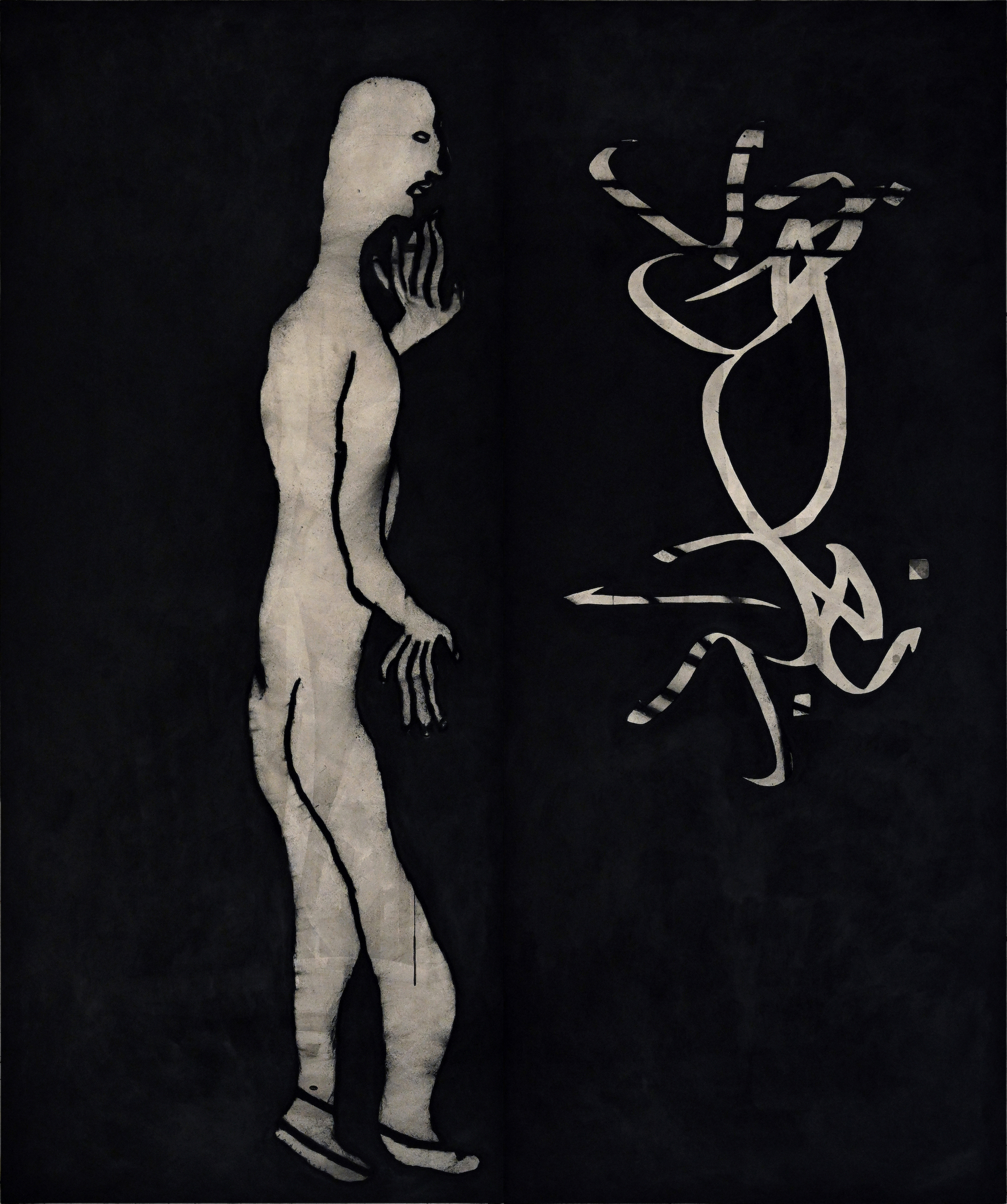
Sadik Kwaish Alfraji , 'Entering Baghdad' , 270 x 226 cm, Oil Colour and Indian ink on canvas, 2022
You predominantly use a sombre palette, what does that evoke for you and is connected to?
It relates to my upbringing in the city of revolution in Baghdad, the colour black was more apparent and intense than any other colour, due to the vast amount of deaths there were and with that the prevailing sad sentiments at the heart of society, its customs, its religious, and social occasions which in general would be steeped in agony.
My sombre palette also connects to my extensive enthusiasm for German expressionism, and goes back to my years studying at the Institute and Academy of Fine Arts in Baghdad with the graphic techniques available there, such as engraving, printing on wood or zinc, that I was so fond of and became addicted to working with throughout the eighties.
أنت في الغالب تستخدم الألوان الداكنة ، فماذا يعني ذلك بالنسبة لك وما يرتبط به؟
غلبة اللون ا لاسود بشكل كبير عندي يعود الى وقت طويل يمتد الى سنين دراستي للفن في معهد واكاديمية الفنون الجميلة في بغداد.. كنت اميل له مزاجيا بسبب ع لاقته القوية مع نشأتي في مدينة الثوره في بغداد، حيث كان وجود اللون ا لاسود من حولي اكثر زخماً ووضوحا من بقية ا لالوان، وذلك بسبب كثرة ا لموت، وغلبة الوجدان الحزين في نفوس ا لمجتمع وعاداته ومناسباته الدينية وا لاجتماعيه، التي تأخذ في مجملها شكلا دراميا ممزوج باللوعة .. ثم بعد ذلك، وخ لال دراستي، اقترن هذا اللون بحبي الكبير للتعبيرية ا لالم انية، ولتقنيات الجرافيك التي احببتها بشده، كطباعة الحفر على الخشب او الزنك، والتي ادمنت العمل بها طيلة فترة الثمانينات، وهي تقنيات تتوفر متطلباتها في معهد الفنون الجميلة واكاديمية الفنون الجميلة في بغداد

Sadik Alfraji, 'Al-Thawra Streets 2021', 2021, Video, sound, 58.31 min, Edition of 5 + 1AP
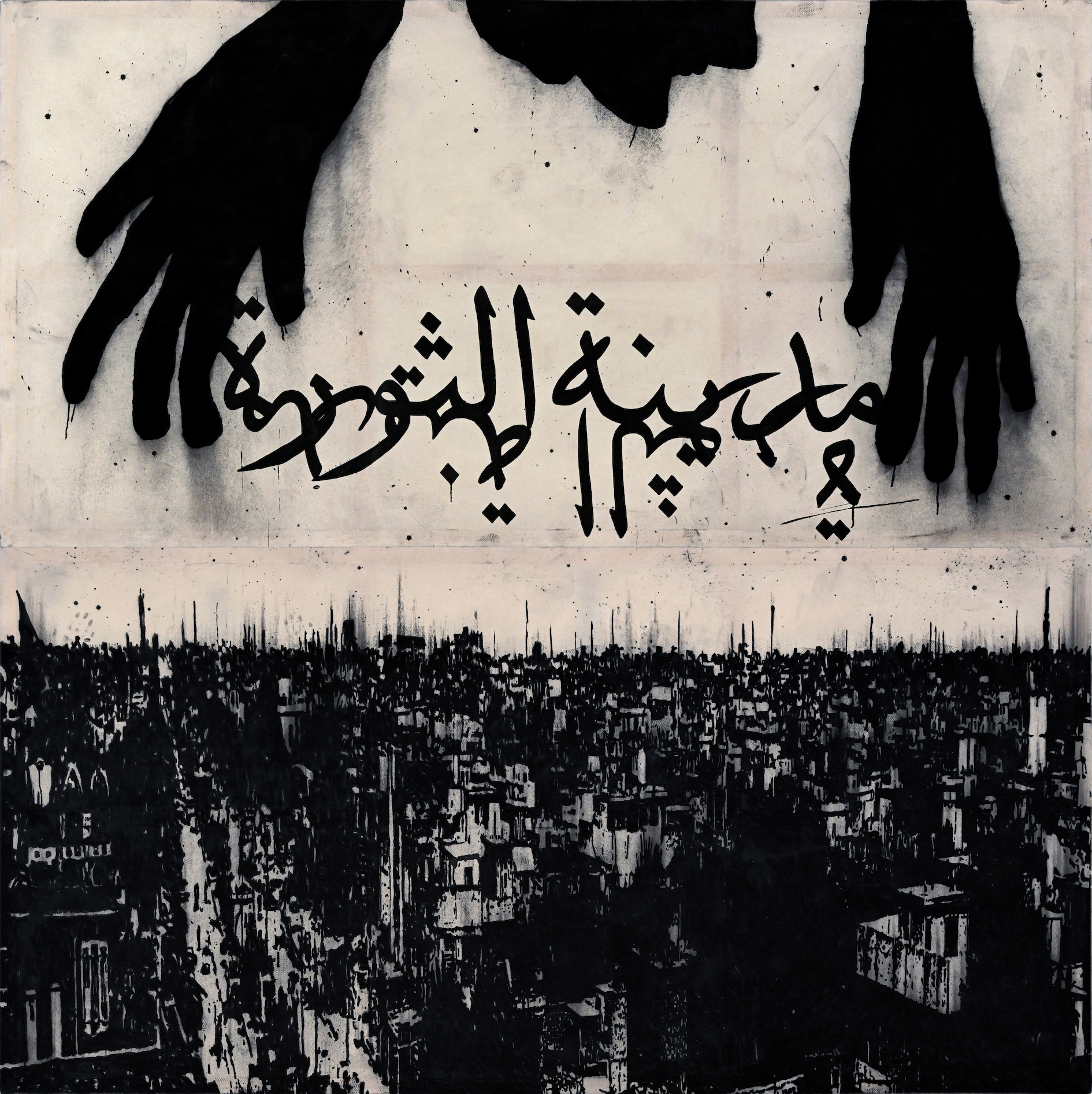
Sadik Alfraji 'Create a City of Love and Nightmares' 301 x 302 cm. Indian ink and Charcoal on canvas 2023
You have previously mentioned, that during the period in which you were living in Iraq, you could see that art in general was being used by the authorities as a tool for propaganda purposes. How did you get around censorship and share through your art, your expressions and thoughts? What were some of your emotions about exhibiting your work in that climate?
In general, the regime’s machinery worked to make all cultural activities serve the ideology of the ruling party, organising exhibitions and festivals accompanied by some critical research activities that leaned towards the same direction as the establishment. However, because art can exude multiple interpretations, an artist was able to produce work that could be perceived differently from the actual idea that they had intended for their art. This gave artists the ability to manoeuvre and protect themselves, all whilst, having the capacity to feel free in their art studio and produce artworks that would be compatible with their own thoughts.
As for me, I did not show much then, what I exhibited were works that could bear more than one interpretation or meaning. For my artworks that emitted a clear idea about war, death, killing, madness, alienation and everything related to that, I never exposed them, many of which were very small, mostly graphic works.
لقد ذكرت سابقا أنه خلال الفترة التي كنت تعيش فيها في العراق ، رأيت أن الفن بشكل عام كان يستخدم من قبل السلطات كأداة لأغراض دعائية.
كيف تمكنت من الالتفاف حول الرقابة ومشاركة تعابيرك وأفكارك من خلال فنك؟
ما هي مشاعرك بشأن عرض عملك في هذا المناخ؟
نعم، بشكل عام كانت ماكنة النظام تعمل على جعل كل ا لانشطة الثقافية في خدمة ايديولوجية الحزب الحاكم من خ لال تنظيم معارض ومهرجانات، يرافق ذلك بعض ا لانشطة النقدية والبحثية التي تصب في نفس اتجاه خدمة النظام.. لكن بسبب ان الفن التشكيلي الحديث يمكن تفسيره بتفسيرات متعددة، فان الفنان كان يستطيع ان ينتج فناً يستطيع ان يعطيه تفسيراً مختلفاً عن الفكرة الحقيقية التي يقصدها في عمله، وهذا اعطى الفنان قدرة على ا لمناورة في حماية نفسه، وفي نفس الوقت القدرة على ان يكون حرا داخل مرسمه وينتج ما يتلائم مع حريته
فيما يتعلق بي فانا لم اعرض كثيراً، وكل الذي عرضته كان من النوع الذي يحتمل اكثر من تفسر أو معنى.. اما ا لاعمال ذات الفكرة الواضحة حول الحرب وا لموت والقتل والجنون وا لاغتراب وكل ما يتصل بالوضع العام، فانني لم اعرضها ابدا، وهي كثيرة جدا، ومعظمها اعمال جرافيكية صغيرة الحجم
The three chapters from ‘Books of Passage’ look at how your grandfather’s, father’s and your own identity have been shaped in relation to war, migration and exile. Can you tell us about those three chapters, your visual communication on identity, and the different artistic mediums you use to express yourself regarding those notions?
'Books of Passage' is an ongoing project looking at the issue of migration and what that holds, such as, loss, hope, disappointments, memories, nostalgia, how those elements can create a dark hole within our identity as well as develop anxiety in between the different layers that make up our identity. Because the topic of migration is huge and extends to more than one generation, it consists of three chapters.
The first chapter entitled 'That River That Was in the South', concerns my grandfather’s generation who lived under the weight of the oppressive feudal system, resulting in a large migration from the south to the city of Baghdad in search of a better life.
The second chapter entitled 'Those Houses Behind the Army Canal', covers my father’s generation, their emigration to Baghdad, displacement and resettlement within Baghdad itself, only to end up with them living in miserable conditions of life.
The last chapter is about my generation who had to migrate outside of Iraq, living between two cultures or more, with the many layers of memories and loss.
In all three chapters, I am a storyteller that analyses and explores culture, identity, and the events that shape and affect it. I relay stories that I have heard, felt, have entered my soul, and correspond with my own life stories, from people I have lived with and amongst. I deliver them through animation, video, printing, drawing, planning, sculpting, and ready-made objects.
الفصول الثلاثة من " كتب العبور ينظر إلى كيف أن جدك ووالدك و نفسك تم تشكيلها فيما يتعلق بالحرب والهجرة والنفي هل يمكنك أن تخبرنا عن هذه الفصول الثلاثة ، وتواصلك المرئي مع نفسك ، والوسائط الفنية المختلفة التي تستخدمها للتعبير عن تلك المفاهيم؟
كتب العبور هو مشروع مستمر أتناول فيه موضوع الهجرة وماتحمله من فقدان وأمل وخيبات وذاكرة وحنين، وكيف ان كل ذلك يؤدي الى خلق ثقب معتم داخل الهوية يجعلها قلقة بين طبقات منفصلة داخلها. ولان ا لموضوع طويل ويمتد لاكثر من جيل فانه يتكون من ثلاثة فصول
فصل اول بعنوان ذلك النهر الذي كان في الجنوب عن جيل جدي الذي عاش تحت وطأة النظام ا لاقطاعي الظالم، ا لامر الذي نتج عنه هجرة كبيرة من الجنوب الى مدينة بغداد بحثا عن حياة افضل
الفصل الثاني بعنوان تلك البيوت التي خلف قناة الجيش وهو عن جيل أبي وهجرتهم الى بغداد، ومن ثم التهجير واعادة التوطين داخل بغداد نفسها، لينتهي ا لامر بهم الى العيش في شروط حياة بائسه
أما الفصل ا لأخير فهو عن جيلي أنا الذي إضطر الى الهجرة الى خارج العراق، وعاش بين ثقافتين او اكثر، وتعددت عنده طبقات الذاكرة والفقدان
في كل هذه الفصول الثلاثة أجد نفسي حكواتيا يحلل وينقب في حكاياته عن الهوية والثقافة وا لاحداث التي تكونها وتؤثر فيها.. هي حكايات ناس عشت بينهم ومعهم او سمعت قصصهم التي تداخلت مع حياتي وقصصي الشخصية، مستخدماً في ذلك وسائط متعددة اجدها مناسبة لتوصيل ا لمفهوم الذي اريد ايصاله، كا لانميشن والفديو والطباعة والرسم والتخطيط والنحت وا لاشياء الجاهزة
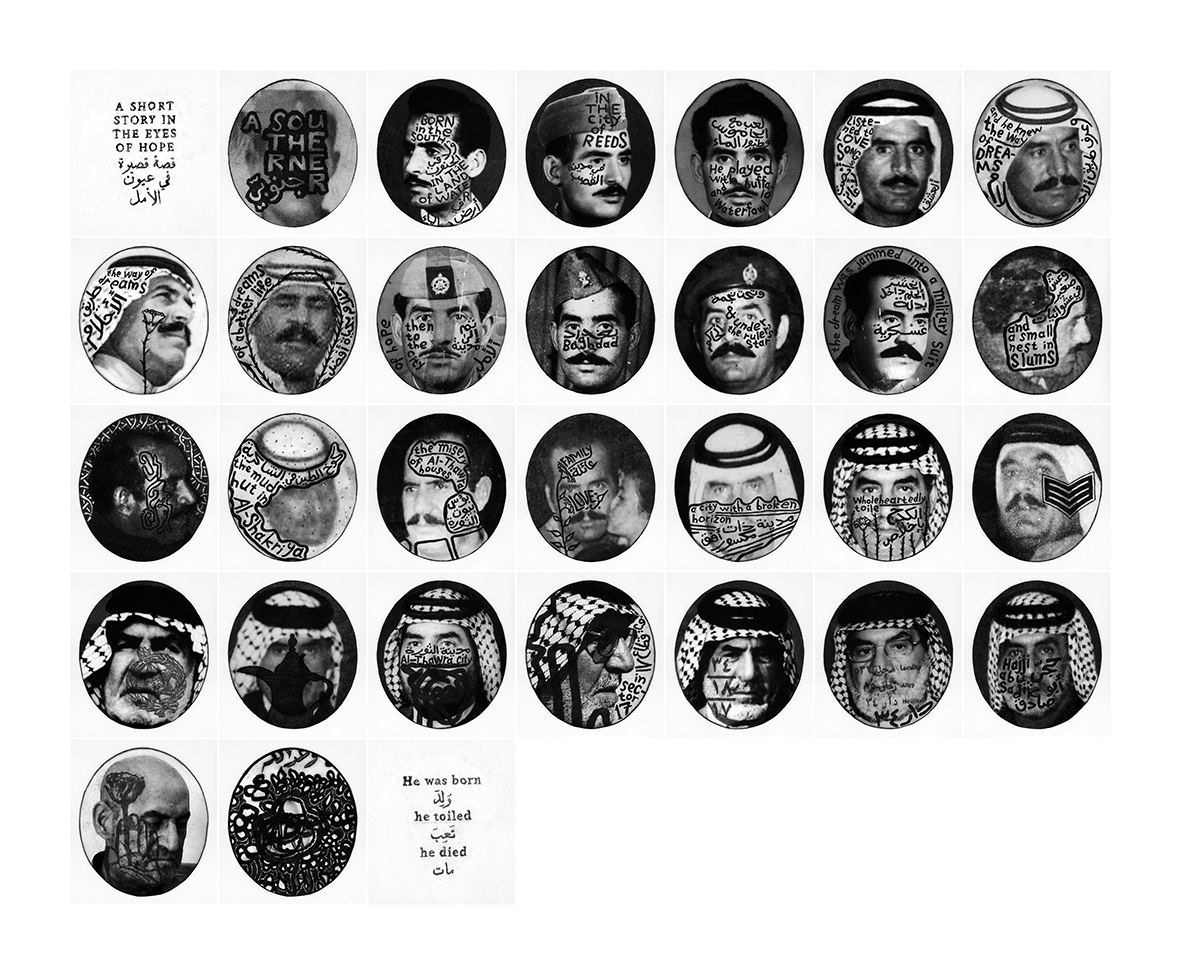
Sadik Kwaish Alfraji, 'A Short Story', Digital Print, 31 pieces, 19,5 x 22 cm each, approximate size 122 x 155 cm, 2023, Edition of 5
.%20Digital%20print%2C%202021%2C%20Edition%20of%205.jpg)
Sadik Kwaish Alfraji 'Print Series Slum Book 1' (31 Pieces, each 24,5 x 60 cm, approximate size 171,5 x 300 cm). Digital print, 2021, Edition of 5
Reflecting on memory taking on layers, the personal, collective, incomplete or imagined, can you share your thoughts on how those layers come into your work, and how they develop?
Migration causes the memory to embody several layers. When moving to another city or country, old memories from one’s home or homeland can shut down, and a new memory can form in relation to the new place one finds oneself in. Thus, the layers that shape our memory overlap with each other with different degrees of clarity or blurriness.
If migrating to a place where the culture is largely different from one’s homeland, then a new memory taking shape, will inevitably feel isolated from one's earliest memories, and this isolation can project itself onto how we view our identity. In other words, anxiousness can create a vacuum within one’s identity, and merging all the different layers of memories will become harder.
Now how does that appear in my work? It is difficult to explain this…I am trying to reformulate my memory by evoking it in the form of stories or quick visions that come to me, rapid flashes that appear here and there and meet each other in art, to form a dialogue that the viewer can interact with.
فيما يتعلق بأخذ الذاكرة في طبقات ، الشخصية أو الجماعية أو غير المكتملة أو المتخيلة ، هل يمكنك مشاركة أفكارك حول كيفية ظهور هذه الطبقات في عملك وكيف تتطور؟
طبقات الذاكره تأتي من تعدد ا لامكنة التي ننتقل اليها.. فانت ح ين تهاجر الى مدينة اخرى ستغلق مرحلة/ طبقة مدينتك ا لاولى وتبدا عندك ذاكرة جديدة تنتمي الى ا لمدينة الجديدة.. وهكذا تتكون طبقات الذاكرة، التي تتداخل مع بعضها بدرجات مختلفة من الوضوح او الضبابية.. لكنك اذا هاجرت الى مكان تختلف فيه الثقافة اختلافا كبيرا عن ثقافة مكانك ا لاول، فان طبقة الذاكرة الجديدة ستكون اكثر انفصا لا عن ذاكرتك ا لاولى، وسيكون هناك فجوة تتوسط الذاكرة وتنتقل الى الهوية ذاتها.. اقصد ان فجوة معتمة ستتوسط هويتك.. ستكون اكثر قلقا، وسيكون اندماج الذاكرتين اكثر صعوبة
ا لآن كيف يظهر ذلك في اعمالي؟ من الصعب ان اوضح ذلك.. انني احاول ان اعيد صياغة الذاكرة من خ لال استحضارها في هيئة حكايات او رؤى سريعة مثل فلاشات سريعة تظهر هنا وهناك لتقابل بعضها وتشكل حوارا يتفاعل معه ا لمشاهد
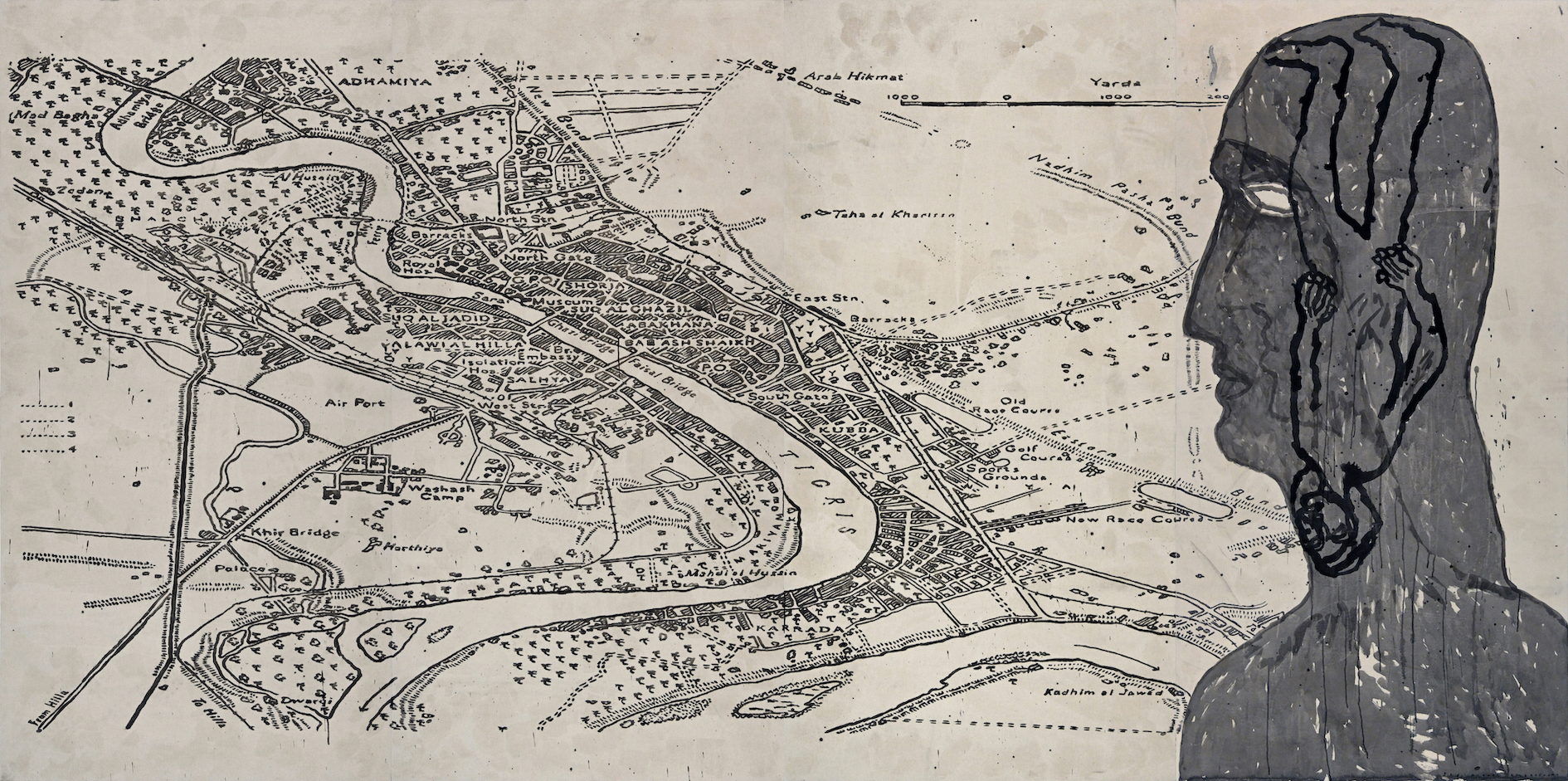
Sadik Kwaish Alfraji, 'Looking Towards Baghdad' ,243 x 488 cm, Indian ink on canvas, 2021

Sadik Kwaish Alfraji, 'A City With A Broken Horizon', 452 x 270 cm, Indian ink and acrylic on canvas, 2023
Across ‘Books of Passage’, though each is in a particular time frame, the different generations will have encountered related circumstances. Do you create or sense similar sentiments traversing time?
Yes of course, there are always common feelings and concerns, even if time or place differs. Related situations and sentiments with close ones across time, is a familiar factor in humanity.
To get closer to the circumstances experienced by my father’s or grandfather’s generation, I created imaginary dialogues with the characters in my diary books (these notebooks contain texts and sketches), conversations that jump from one situation to another, and where I sometimes would assume the character of my grandfather or my father, talking as them, in order to feel closer to the situation they were in. This technique was of considerable help in building the image of the story that you can see in the works ‘Those Houses Behind The Army Canal’, the second chapter of ‘Books of Passage’. Assuming my father's experience as if it were my own, to feel what he feels, and live with him, in his dreams, fears, anxieties, wishes, anguish of loss, and so forth, placed me in the middle of his journey, unfolding as if it were my own path.
عبر كتب المرور ، على الرغم من أن كل منها في إطار زمني مختلف ، فإن الأجيال المختلفة تواجه ظروفًا ذات صلة. هل خلقت أو شعرت بمشاعر مماثلة تعبر الزمن؟
نعم بالتأكيد هناك دائماً مشاعر وهموم انسانية مشتركة، حتى وإن اختلف الزمن او ا لمكان.. فا لامر هكذا مع كل ما هو إنساني. ولكي اقترب اكثر من الحالة التي عاشها جيل والدي او جدي، فاني إتبع ُت طريقة الحوار التخيلي مع هذه الشخصيات في دفاتر يومياتي، )وهي دفاتر تحتوي على نصوص وإسكتشات(، حوار يقفز من حالة الى اخرى، واحيانا اتقمص فيه شخصية جدي او والدي، واتحدث بلسانهم لاكون اقرب الى الحالة التي هم فيها. هذا التكنيك في الواقع قد ساعدني كثيرا في بناء صورة الحكاية التي يمكنك ان تشاهدها في اعمال هذا ا لمشروع
واعيش معه اح لامه ومخاوفه وقلقة وامنياته ومرارة الفقدان الذي تعرض لها، الى اخر ذلك، حتى اكون في وسط رحلته لتتكشف لي وكأنها رحلتي انا
How did your own memories affect the second chapter?
My memory is an integral part of the second chapter, I cannot separate it from my father's own journey, because I am an integral part of it, and by the same token, his path is also an essential part of my journey. Of course, in the third chapter, there will be much about my father, the family and community I grew up with.
كيف أثرت ذكرياتك على الفصل الثاني؟
ذاكرتي هي جزء اصيل في الفصل الثاني ولا استطيع ان افصلها عن رحلة أبي.. لانني جزء مكمل لتلك الرحلة.. وبا لمثل فهي ايضا جزء مكمل لرحلتي. بالتأكيد فان الفصل الثالث، سيكون فيه جانبا كبير من والدي والعائلة وا لمجتمع الذي نشأت فيه داخل تلك ا لمدينة
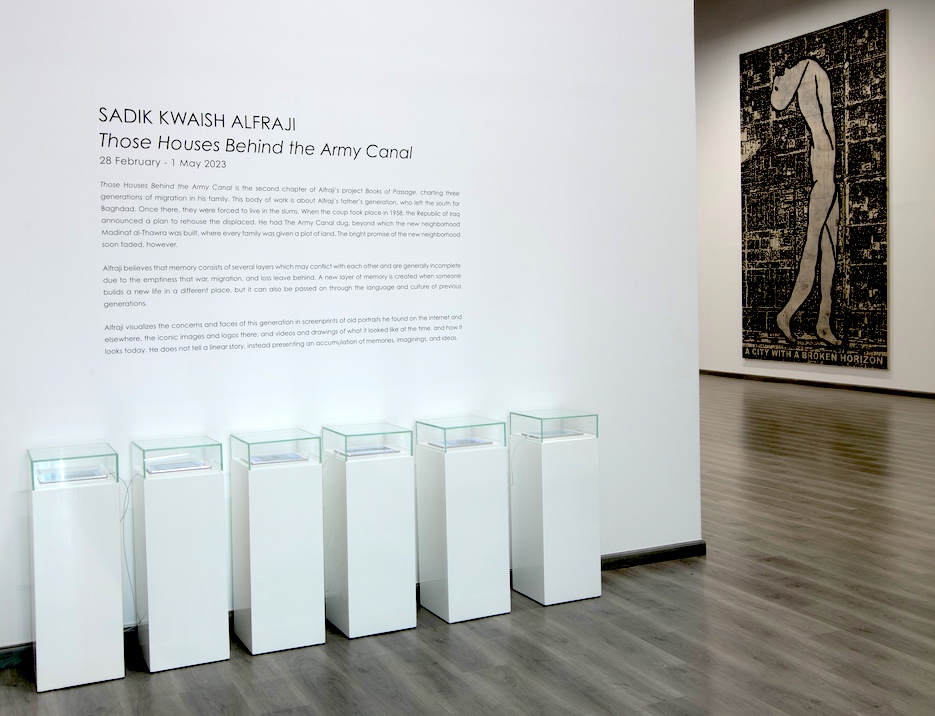
Sadik Kwaish Alfraji's exhibition at Ayyam Gallery, Dubai
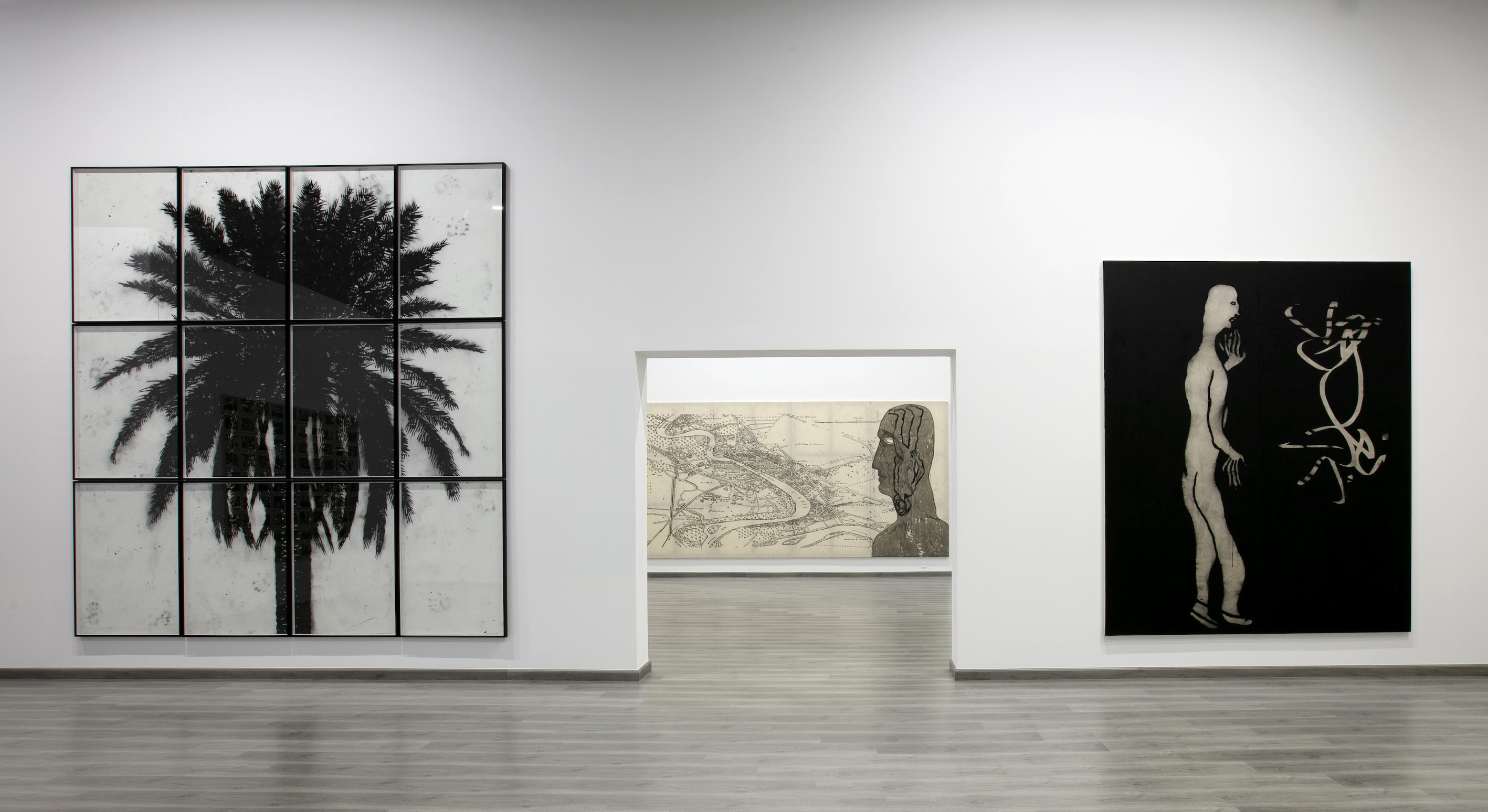
Sadik Kwaish Alfraji's exhibition at Ayyam Gallery, Dubai, with artworks from left: Sadik Alfraji 'Palm Tree in Square 55' 330 x 300 cm. Indian ink and Charcoal on paper 2022; Sadik Kwaish Alfraji, 'Looking Towards Baghdad' ,243 x 488 cm, Indian ink on canvas, 2021; Sadik Kwaish Alfraji , 'Entering Baghdad' , 270 x 226 cm, Oil Colour and Indian ink on canvas, 2022
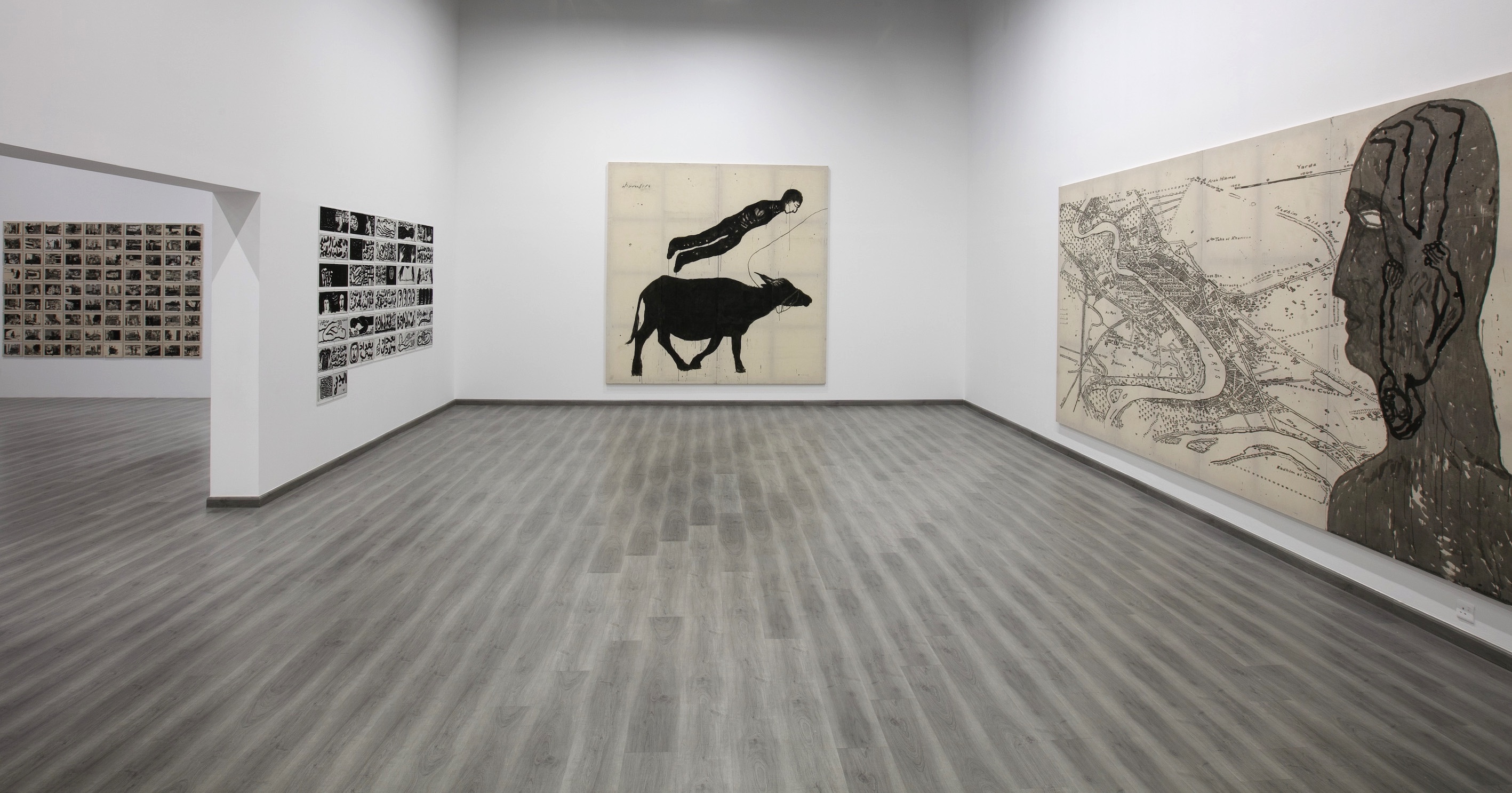
Sadik Kwaish Alfraji's exhibition at Ayyam Gallery, Dubai, with artworks from left: Sadik Alfraji 'At Home in the Alley' (90 Pieces, each 20 x 26,5 cm) approximate Size 188 x 269 cm. Indian ink on canvas 2021; Sadik Kwaish Alfraji 'Print Series Slum Book 1' (31 Pieces, each 24,5 x 60 cm, approximate size 171,5 x 300 cm). Digital print, 2021, Edition of 5; Sadik Kwaish Alfraji, 'Blind Qasim and His Beautiful Buffalo', 301 x 302cm, Indian ink on canvas, 2021; Sadik Kwaish Alfraji, 'Looking Towards Baghdad' ,243 x 488 cm, Indian ink on canvas, 2021

Sadik Kwaish Alfraji at his exhibition at Ayyam Gallery, Dubai, next to artworks: Sadik Alfraji 'A Tireless Worker 1' 160 x 200 cm. Indian ink and Charcoal on canvas, 2022; Sadik Alfraji 'A Tireless Worker 2' 140 x 210 cm. Indian ink and Charcoal on canvas, 2022
How will the third chapter present itself, will there also be diaries with a dialogue between yourself and your father or grandfather?
Yes, I will adopt that technique as well, as it will push me to further understand the present, helping to develop the concept for the third chapter, with its multiple layers that belong to different cultures. The layers will face each other through a diverse body of work and the different elements that make them up.
كيف سيكون ا لامر في الفصل الثالث.. هل سيكون هناك دفاتر يوميات ايضا فيه حوار بيني وبين ابي او جدي ؟
نعم بالتأكيد ساعتمد ذلك ايضا، لانه سيجعلني افهم الحاضر اكثر، ويساعدني في تطوير ا لمفهوم في الفصل الثالث، وطبقاته ا لمعقدة التي تنتمي الى ثقافات مختلفة. طبقات ستواجه بعضها البعض من خ لال تنوع ا لاعمال والعناصر التي تكونها
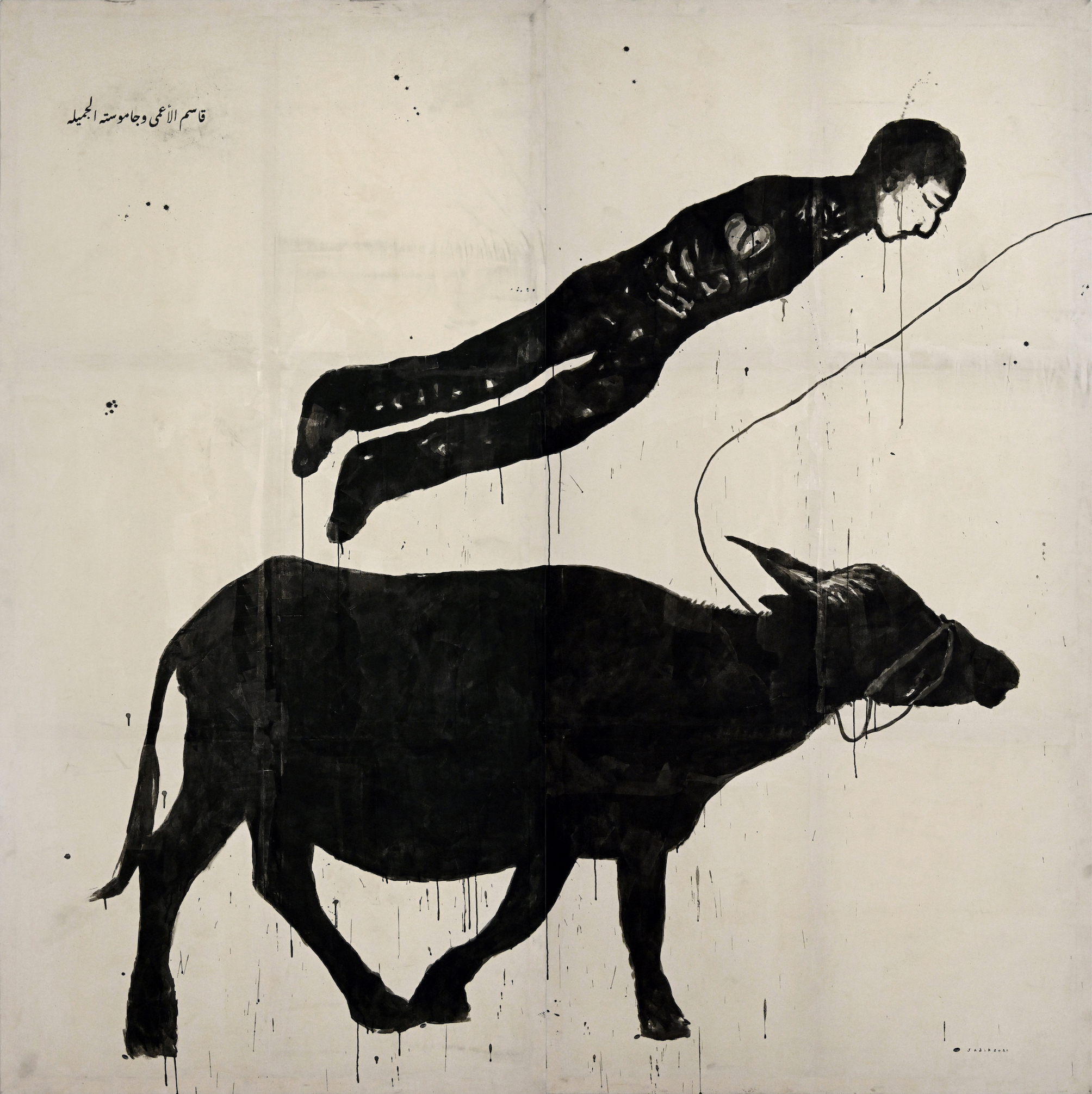
Sadik Kwaish Alfraji, 'Blind Qasim and His Beautiful Buffalo', 301 x 302cm, Indian ink on canvas, 2021
Born in Baghdad, Iraq in 1960, Sadik Kwaish Alfraji lives and works in Amersfoort, Netherlands. He received a Bachelor of Fine Art in Painting and Plastic Art from the Academy of Fine Arts, Baghdad in 1987 and a High Diploma in Graphic Design from CHK Constantijn Huygens, Netherlands in 2000.
The artist’s solo shows include Kunsthal KAdE, Amersfoort (2022); Museum Flehite, Amersfoort (2021); L'appartement 22 art, Morocco (2020); 21st Contemporary Art Biennial Sesc_Videobrasil, Brazil (2019), Ayyam Gallery (2019, 2017, 2015, 2013, 2011); Maraya Art Centre, Sharjah (2017); Red Star Line Museum, Antwerp (2016); Galerie Tanit, Munich (2016); Beirut Exhibition Center, Beirut (2014); Stads Gallery, Amersfoort, Utrecht (2010); Station Museum, Houston (2008); Stedelijk Museum, Amsterdam (2007).
Selected group exhibitions include 21,39, Jeddah (2022); Stedelijk Museum, Amsterdam (2021); Cairo International Biennale, Egypt (2019); 9th Asia Pacific Triennial Of Contemporary Art, Australia (2018); Katzen Arts Center, USA (2018); the Katzen Art
Center, American University Museum, Washington (2017); Iraq Pavilion of the 57th Venice Biennale, Venice (2017); British Museum, London (2017, 2015); TRIO Biennial, Rio
de Janeiro (2015); P21 Gallery, London (2015); 56th Venice Biennale, Venice (2015); Abu Dhabi Festival, Abu Dhabi (2015); Maraya Art Centre, Sharjah (2015); LACMA, Los Angeles (2015); FotoFest Biennial, Houston (2014); Samsung Blue Square and Busan Museum of Art, Seoul & Busan (2014); Ikono On Air Festival, online and broadcasted (2013); Mori Art Museum, Tokyo (2012); Institut du Monde Arabe, Paris (2012); Centro Cultural General San Martin, Buenos Aires (2012); and Mathaf: Arab Museum of Modern Art, Doha (2010).
Alfraji’s works are housed in private and public collections including Stedelijk Museum, the British Museum, London; National Museum of Modern Art, Baghdad; The Art Center, Baghdad; National Gallery of Fine Arts Amman; Shoman Foundation, Amman; Royal Association of Fine Arts, Amman; Novosibirsk State Art Museum, Russia; and Cluj- Napoca Art Museum, Romania; Los Angeles Country Museum; Mathaf: Arab Museum of Modern Art, Doha; and Museum of Fine Arts, Houston. A monograph on the artist edited by Nat Mueller was published in 2015 (Schilt Publishing, Amsterdam).
%20approximate%20Size%20188%20x%20269%20cm.%20Indian%20ink%20on%20canvas%202021.jpg)
Sadik Alfraji 'At Home in the Alley' (90 Pieces, each 20 x 26,5 cm) approximate Size 188 x 269 cm. Indian ink on canvas 2021
Sadik Kwaish Alfraji ‘Those Houses Behind the Army Canal’, the second chapter of 'Books of Passage' currently on at Ayyam Gallery in Dubai until 1 May 2023
Pictures courtesy of Ayyam Gallery and Sadik Kwaish Alfraji, © Sadik Kwaish Alfraji
Interview answers originally in Arabic and translated to english
